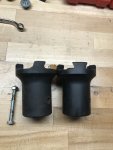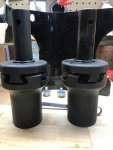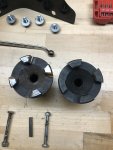You can tell your service guy that mine lasted about 20 hrs.I have seen a couple posts on here.....are there more?
I dropped of my K Connect and the service tech (nice guy) said he has never seen anything like premature wear like mine had......
Let's be clear here, my blower and K Connect have maybe 35-40hrs total on the units over 3 seasons. It has NEVER been engaged above idle rpm........has it been run while "fully lifted"? yes, of course, fully lifted at 8-10" barely clears the snow we get regularly......AND I have scoured the manuals and there is nothing that says anything about NOT lifting the blower the full travel of the K Connect while running.
In float while blowing the blower does move around a fair amount by design, which is the way it is supposed to work......if Kutbota's "commercial" system cannot handle residential use and requires major parts replacement every 35hrs of use I feel it should be covered under lifetime warranty unless a new engineered solution can be provided.
I have a feeling the dealer will stick me with the bill on this one........let's see what happens.
Kubota K Connect Snowblower problems explained.
- Thread starter DustyRusty
- Start date
Sad.......and shame on Kubota for making this our problem.You can tell your service guy that mine lasted about 20 hrs.
I have to swap from FEL to blower in the next couple weeks and honestly, I look at that $8K orange beast and I don't have the level of confidence I should in it........
And I am PISSED the dealer and Kubota put this on me when I use this thing like a delicate flower compared to what an actual "commercial" user would.......
$700 wearable part that eats itself in 20-35hrs of use........shameful
Where is Kubota on this forum?
EDIT: I think I will document the wear in pictures this season......with the total hours of usage......
Last edited:
I spent a lot of time analyzing the problem and being that I have both the homeowner version snowblower and the commercial version of the snowblower the issue doesn't change one bit. It is the lifting of the snowblower that is the culprit. Last winter I was experimenting with wooden blocks to limit the amount of lift that the blower would have, but never found an easy solution of keeping the wooden block in place. I just resigned myself to only lifting the blower the bare minimum to prevent the wear of the cogs. There is a local business that does heat-treating hardening of steel, so if I have to replace mine, I will have the replacement parts hardened first. I just hope that they will do a single part for me. I feel relatively confident that the steel that RAD Technologies Inc. (manufacturer of the Kubota snowblowers) is a mild steel that can't hold up to the abuse that the K Connect puts on it. I have no idea if Kubota Corporate is even aware of the problem because many times it never goes beyond the local district manager when a problem such as this occurs.
I believe that if we all were to complain to the manufacturer it would get their attention and their engineering staff will need to address the failures. The manufacturer has an excellent reputation in the manufacturing sector for providing quality snow removal equipment. The most important thing that all of us can do is to photo document the failures and whenever possible get the defective parts back into your hands for analysis by the manufacturer.
One final thought, there is a small 1/4" diameter bolt that holds the cog to the snowblower. It is a grade 5 bolt as best as I can tell, since the service replacement has no head markings. I have purchased this bolt from 3 different Kubota dealers, and not once did it come in a Kubota package. This leads me to believe that the dealer's parts department is buying this part in volume and not from the snowblower manufacturer. My snowblower has broken this bolt multiple times, and while the part has never fallen off, it does allow the part to move both for and aft. I was advised not to replace this with a harder bolt in the past and I have headed that advice. I am wondering if a stronger bolt might be a better choice. If you have experienced this bolt failure, please tell us how often and what you have done about replacement bolts. Only our shared knowledge of failure and success will resolve this problem for all concerned. If we keep posting our individual experiences in the same thread, it will help everyone to know that they are not alone,
I believe that if we all were to complain to the manufacturer it would get their attention and their engineering staff will need to address the failures. The manufacturer has an excellent reputation in the manufacturing sector for providing quality snow removal equipment. The most important thing that all of us can do is to photo document the failures and whenever possible get the defective parts back into your hands for analysis by the manufacturer.
One final thought, there is a small 1/4" diameter bolt that holds the cog to the snowblower. It is a grade 5 bolt as best as I can tell, since the service replacement has no head markings. I have purchased this bolt from 3 different Kubota dealers, and not once did it come in a Kubota package. This leads me to believe that the dealer's parts department is buying this part in volume and not from the snowblower manufacturer. My snowblower has broken this bolt multiple times, and while the part has never fallen off, it does allow the part to move both for and aft. I was advised not to replace this with a harder bolt in the past and I have headed that advice. I am wondering if a stronger bolt might be a better choice. If you have experienced this bolt failure, please tell us how often and what you have done about replacement bolts. Only our shared knowledge of failure and success will resolve this problem for all concerned. If we keep posting our individual experiences in the same thread, it will help everyone to know that they are not alone,
Final Thought, I just opened the poll so there is no expiration to the poll, and I also set it so people can change their vote, in the event their experience has changed and added 2 additional questions. If you would like to answer the additional questions, just edit your original vote and vote again. Thanks.
Last edited:
For your viewing pleasure.......this is the faulty coupler they pulled off my unit during the $700 "fix".....mind you this is after 35 HOURS of use MAX......on my own driveway doing what it is designed to do.
I ALWAYS engage the PTO at idle.......I ALWAYS disengage the PTO at idle......just like the manual says. And THIS is what my coupler looked like.
Now here is the oddity of mine in particular......notice the perfect worn notch in the "opposite" direction in which the coupler spins? I have no explanation......





I ALWAYS engage the PTO at idle.......I ALWAYS disengage the PTO at idle......just like the manual says. And THIS is what my coupler looked like.
Now here is the oddity of mine in particular......notice the perfect worn notch in the "opposite" direction in which the coupler spins? I have no explanation......
humour me please. I tried following this PITA system last year over several 'threads'....so maybe a refresh.
My understanding is power from M-PTO goes to small driveshaft to this 'engage/disengage' dog clutch THEN another ujoint to connect to the snowblower. You engage the dog clutch with a lever(maybe spin the shaft a wee bit..), then apply PTO power, blower spins....you never need to disengage the dog clutch all season long.
IF this is correct, raising/lowering the blower will not affect the dog clutch.
My understanding is power from M-PTO goes to small driveshaft to this 'engage/disengage' dog clutch THEN another ujoint to connect to the snowblower. You engage the dog clutch with a lever(maybe spin the shaft a wee bit..), then apply PTO power, blower spins....you never need to disengage the dog clutch all season long.
IF this is correct, raising/lowering the blower will not affect the dog clutch.
Yours is one of the most badly damaged ones that I have seen. I suggest that you send the pictures along with an explanation to the manufacturer and see what they have to say. Here is their email address..... radtech@radtech.ca and their website. https://radtech.ca/en/
Dusty......I just sent them an email with a link to this thread along with my story and pictures......Yours is one of the most badly damaged ones that I have seen. I suggest that you send the pictures along with an explanation to the manufacturer and see what they have to say. Here is their email address..... radtech@radtech.ca and their website. https://radtech.ca/en/
After reading this thread, no way will I buy the front snowblower. Was considering one down the road but not anymore. It’s BS you folks are going through this with the high cost of the blower. Just a thought, anyway you can take that part off and have a machine shop make one with better strength?
Outside of this particular issue (which is a BIG one) the unit is a dream to operate and does exactly what I need it to do.....however this weak link NEEDs to be addressed.After reading this thread, no way will I buy the front snowblower. Was considering one down the road but not anymore. It’s BS you folks are going through this with the high cost of the blower. Just a thought, anyway you can take that part off and have a machine shop make one with better strength?
I implored the manufacturer to explore a different grade of steel etc.
Sounds more like a mechanical re-design is requiredOutside of this particular issue (which is a BIG one) the unit is a dream to operate and does exactly what I need it to do.....however this weak link NEEDs to be addressed.
I implored the manufacturer to explore a different grade of steel etc.
Here are my beauties
Attachments
-
448.9 KB Views: 284
-
374.8 KB Views: 294
-
441.6 KB Views: 281
Obviously my pics are the original and replacement in each photo.Here are my beauties
Here is what the brand new replacement coupler looks like prior to any actual use.......
I am going to try and remember to document the wear/failure of this part over the season.
Top picture is with the spring loaded handle disengaged and the bottom picture is with eh handle fully engaged in the locked ready to run position.


I am going to try and remember to document the wear/failure of this part over the season.
Top picture is with the spring loaded handle disengaged and the bottom picture is with eh handle fully engaged in the locked ready to run position.
Request to River19
could you please post similar picture with 1) engaged- blower on ground and 2) engaged- blower raised up high ?
it'd be nice as 'references'.
I still say that dog clutch is a very,very poor design. Only maybe 1/2 the dog 'faces' are in contact,unlike say a 'Lovejoy' coupling where 100% of the faces mate.
hmm..wonder if anyone with the 'broom' has seen this wear/failure ??
could you please post similar picture with 1) engaged- blower on ground and 2) engaged- blower raised up high ?
it'd be nice as 'references'.
I still say that dog clutch is a very,very poor design. Only maybe 1/2 the dog 'faces' are in contact,unlike say a 'Lovejoy' coupling where 100% of the faces mate.
hmm..wonder if anyone with the 'broom' has seen this wear/failure ??
I will try and remember to document that when I mount the blower, right now it is on a pallet with the K-connect attached as it was returned from the dealer........Request to River19
could you please post similar picture with 1) engaged- blower on ground and 2) engaged- blower raised up high ?
it'd be nice as 'references'.
I still say that dog clutch is a very,very poor design. Only maybe 1/2 the dog 'faces' are in contact,unlike say a 'Lovejoy' coupling where 100% of the faces mate.
hmm..wonder if anyone with the 'broom' has seen this wear/failure ??
But yes, I will do my best to document it.
Runs With Scissors
Well-known member
Equipment
L2501 TLB , Grappel, Brush Hog, Box Blade, Ballast box, Forks, Tiller, PH digger
This is the first time I have ever seen a "K connect" system, so please forgive the dumb question.
Is one of those couplers at rest and the other at "operating speed" when they engage?
Is one of those couplers at rest and the other at "operating speed" when they engage?
If I am understanding your question correctly, the answer is "no" in that this coupler is engaged while the PTO is NOT spinning and really it can be engaged once per season when you mount the blower to the tractor. Then when the PTO is engaged (at idle) the coupler just transfers the power from the PTO>Driveshaft>K-Connect Unit>Coupler>Blower....This is the first time I have ever seen a "K connect" system, so please forgive the dumb question.
Is one of those couplers at rest and the other at "operating speed" when they engage?
I hope that makes sense
Runs With Scissors
Well-known member
Equipment
L2501 TLB , Grappel, Brush Hog, Box Blade, Ballast box, Forks, Tiller, PH digger
I think I get it.Here is what the brand new replacement coupler looks like prior to any actual use.......
I am going to try and remember to document the wear/failure of this part over the season.
Top picture is with the spring loaded handle disengaged and the bottom picture is with eh handle fully engaged in the locked ready to run position.
View attachment 115082 View attachment 115083
So in your bottom pic, that is the way they are when at rest, and the tractor is turned off?
Last edited:
yes...
when you attach the snowblower or broom, you use the lever to mechanically connect the two dog clutch halves.
when you turn On the mid mount PTO, THAT spins all the shafts, ujoints clutch and of course sends power to the snowblower or broom
when you attach the snowblower or broom, you use the lever to mechanically connect the two dog clutch halves.
when you turn On the mid mount PTO, THAT spins all the shafts, ujoints clutch and of course sends power to the snowblower or broom




